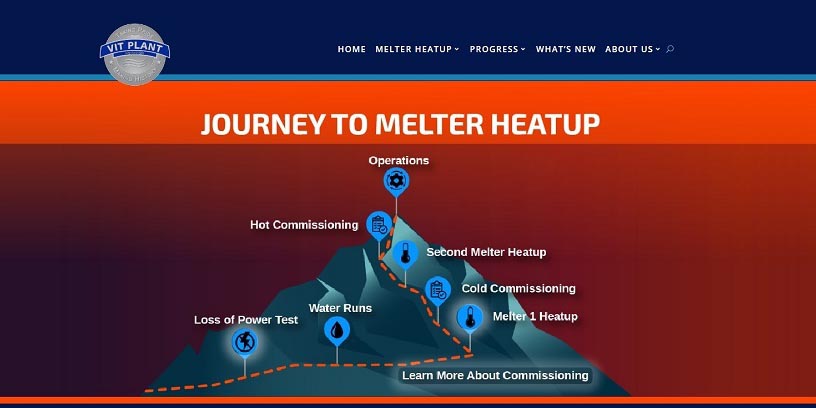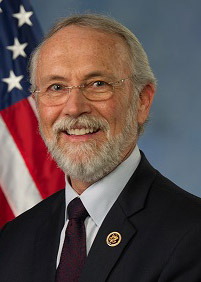In 2020, the DOE announced real progress made in the management of liquid radioactive waste at its sites at Savannah River, Idaho, and Hanford.
Plant startup employees work in the process cell area of the Low-Activity Waste Facility at Hanford’s Waste Treatment and Immobilization Plant.
During the annual National Cleanup Workshop, held virtually in September of last year due to the COVID-19 health crisis, William “Ike” White, senior advisor to the under secretary for science in the Department of Energy’s Office of Environmental Management, said that despite the pandemic, 2020 was an inflection year for the DOE and his office.
SRNS subcontractors Donald Miles and Richard Mooney drill for soil samples as part of a project to immobilize I-129 in the groundwater and soil at the Savannah River Site. Photo: DOE/SRNS
A silver chloride–based cleanup technology is expected to reduce radioactive iodine-129 contamination found in soil and groundwater near the center of the Department of Energy’s Savannah River Site in South Carolina to levels well below regulatory limits. The I-129 was created during the production of plutonium and tritium at the site throughout the Cold War era.
Participating in the ceremony to hand over the ISF-2 operating license are (from left) Valery Seyda, acting director general of the Chernobyl nuclear power plant; Ukrainian President Volodymyr Zelensky; and SNRIU Chairman Grigoriy Plachkov.
Ukraine’s State Nuclear Regulatory Inspectorate (SNRIU) has authorized the operation of Chernobyl’s Interim Storage Facility (ISF-2), allowing spent nuclear fuel from the plant’s three undamaged reactors to be loaded into the dry storage facility. The handover of the ISF-2 operating license was carried out during a ceremony held on April 26, the 35th anniversary of the Chernobyl accident, and was attended by Ukraine’s president, Volodymyr Zelensky.
The New Safe Confinement in final position over reactor 4 at the Chernobyl nuclear power plant in 2017. Photo: Tim Porter
On April 26, 1986, reactor No. 4 of the Chernobyl nuclear power plant in Ukraine exploded, sending radioactive material into the environment and across Europe. After 35 years, Ukrainians are looking to the site of the world’s worst nuclear disaster “for inspiration, solace, and income,” according to an ABC News report.
Waste handlers take radiological readings as a crane lifts containers from a TRUPACT-II cask in the contact-handled waste bay at WIPP. Photo: DOE
The Waste Isolation Pilot Plant in southeastern New Mexico is once again accepting shipments and processing transuranic waste following a two-month annual maintenance outage. According to the Department of Energy, WIPP is back to accepting five waste shipments per week, with post-pandemic plans to increase shipments to 10 per week.
Federal and contractor officials participate in a groundbreaking ceremony for the WEPAR project on April 7 at the Y-12 National Security Complex in Oak Ridge. Photo: DOE
A project to reduce by approximately half the high-security protected area at the Department of Energy’s Y-12 National Security Complex in Oak Ridge, Tenn., will avoid millions of dollars in costs and accelerate cleanup, the DOE’s Office of Environmental Management (EM) announced.
A retired USGS geologist shares his experience of working on the publicly misunderstood nuclear waste repository and its geology.
The author on a typical day at Yucca Mountain, with Solitario Canyon and the flat-topped repository block seen in the background.
SRNS engineers (from left) Will Jolin, John Bradley, and Joao Cardoso-Neto discuss a plan to move and repurpose equipment used at 19 soil cleanup sites. Photo: DOE
A project to passively remove nonradioactive contaminants from the soil and groundwater at the Department of Energy’s Savannah River Site in South Carolina is coming to an end, as workers prepare to remove solar-power “plugs” from 19 soil remediation locations at the site.
The NRC-licensed independent spent fuel storage installation at Zion, Ill.
A radiological worker surveys the inside of a TRUPACT-II containment lid during waste handling operations at WIPP. Photo: DOE
Crews move equipment used to inspect drums holding diluted plutonium into a storage site in K Area at the Savannah River Site. Photo: DOE
Workers at the Department of Energy’s Savannah River Site in South Carolina recently finished transferring equipment to the site’s K Area in preparation of shipping downblended plutonium to the Waste Isolation Pilot Plant in New Mexico for disposal. The plutonium is part of the 34 metric tons of surplus plutonium the National Nuclear Security Administration plans to ship to WIPP under the “dilute and dispose” option the department adopted following the cancellation of the MOX Fuel Fabrication Facility project.
Workers remove asbestos siding panels from a Portsmouth Gaseous Diffusion Plant building. Photo: Business Wire
Fluor-BWXT Portsmouth, a joint venture of Fluor and BWX Technologies, along with engineering company Jacob, have received a contract extension valued at up to $690 million, including options, from the Department of Energy. The contract, announced April 6, is for environmental management work at the former Portsmouth Gaseous Diffusion Plant near Piketon, Ohio.
Dry cask storage at the closed San Onofre Nuclear Generating Station in Southern California. Photo: Southern California Edison
Saying they are cautiously optimistic that the Biden administration can change the U.S. trajectory on nuclear waste, some Stanford University experts have offered their recommendations on how it can be done in a recent Stanford news posting.
A front-and-back illustration of the new Hanford ETF filter system, which is intended to eliminate the need to shut down operations every 12 hours to replace filters during wastewater processing. Image: DOE
A new wastewater filter system being installed at Hanford’s Effluent Treatment Facility (ETF) is expected to increase waste processing throughput, improve efficiency, and save money as the site in southeastern Washington gears up to treat tank waste, the Department of Energy announced.
The Mexican spotted owl, which finds a home in northern New Mexico’s canyons and forests, is a threatened species that the DOE strives to protect. Photo: Don Ulrich, taken in Flagstaff, Ariz.
To protect a treasured ecological species of northern New Mexico, the Los Alamos Field Office (EM-LA) of the Department of Energy’s Office of Environmental Management and its contractor N3B this month began their annual task of modifying legacy waste cleanup activities at Los Alamos National Laboratory ahead of the Mexican spotted owl breeding season.
The U.S. Fish and Wildlife Service (USFWS) listed the owl as a threatened species in 1993, when population numbers were decreasing drastically due to the loss, degradation, and fragmentation of their habitat.
Holtec’s proposed HI-STORE interim storage facility. Image: Holtec
New Mexico attorney general Hector Balderas has filed suit against the Nuclear Regulatory Commission and the United States, seeking to stop Holtec International’s application to build and operate its HI-STORE consolidated interim storage facility for used nuclear fuel in the state. The complaint, filed in the U.S. District Court of New Mexico on March 29, seeks a declaratory judgment that the NRC is acting beyond the scope of its authority and an injunction preventing the licensing from moving forward.





















